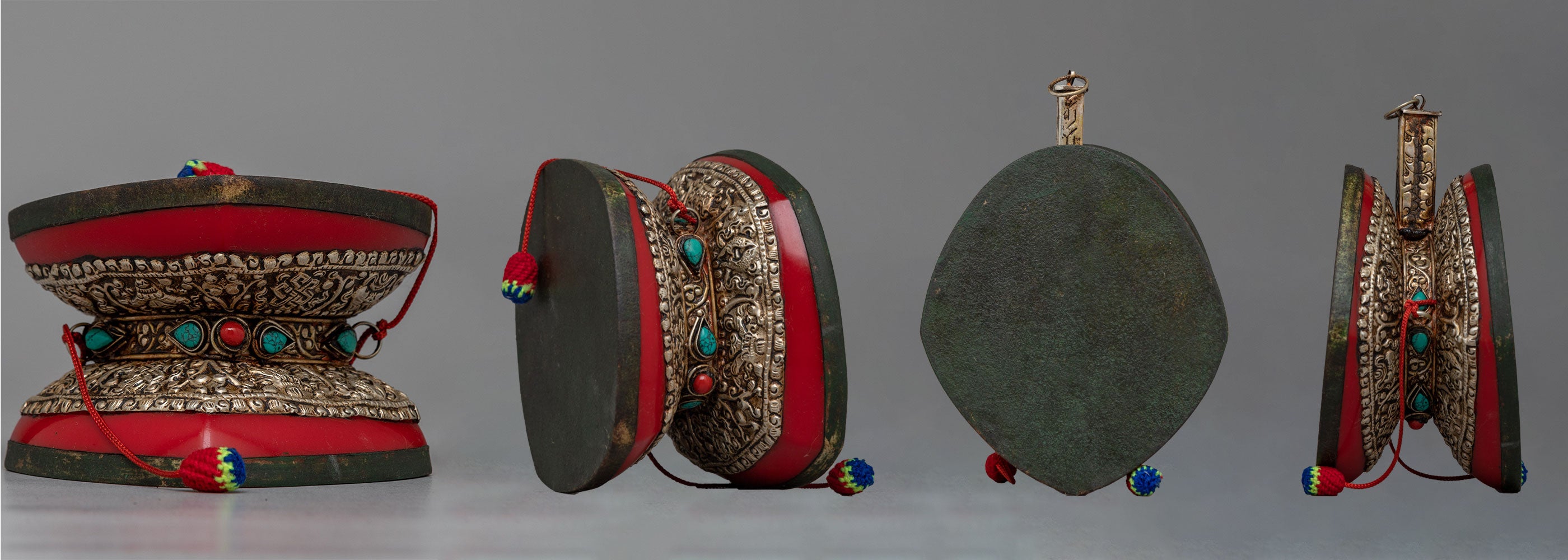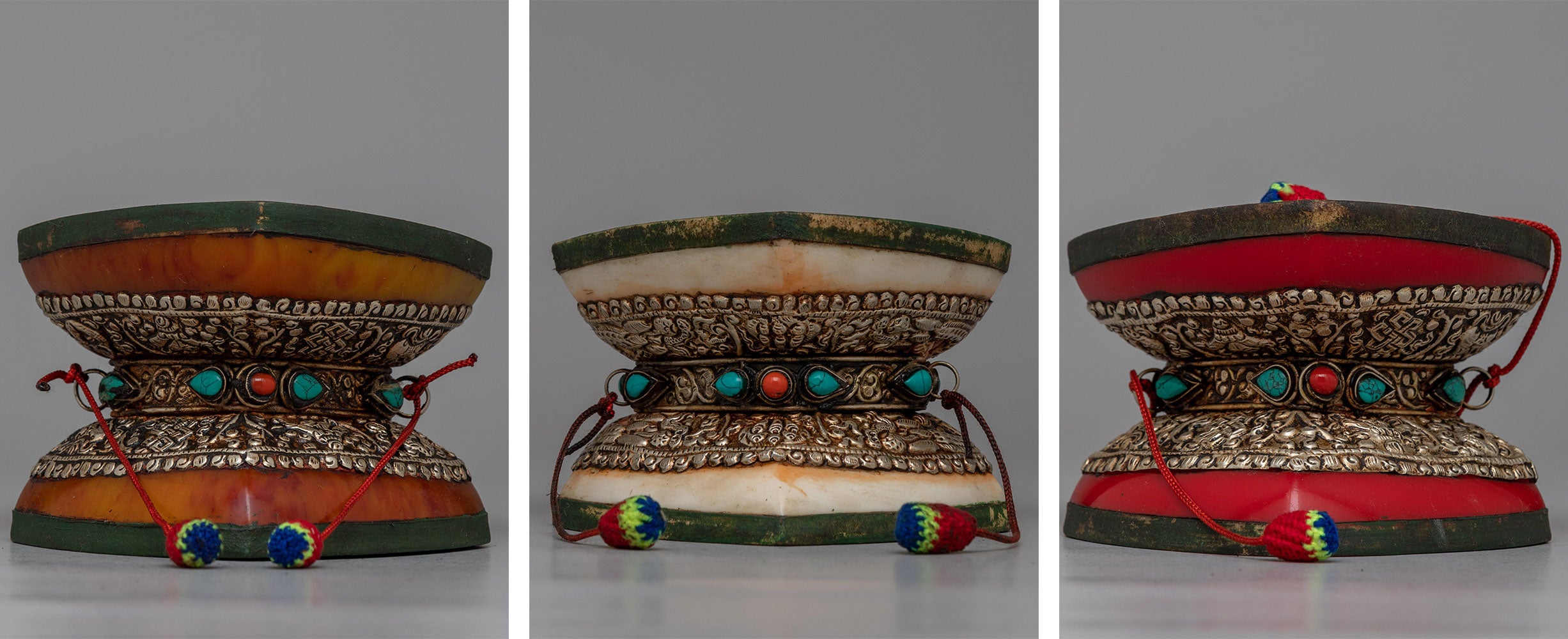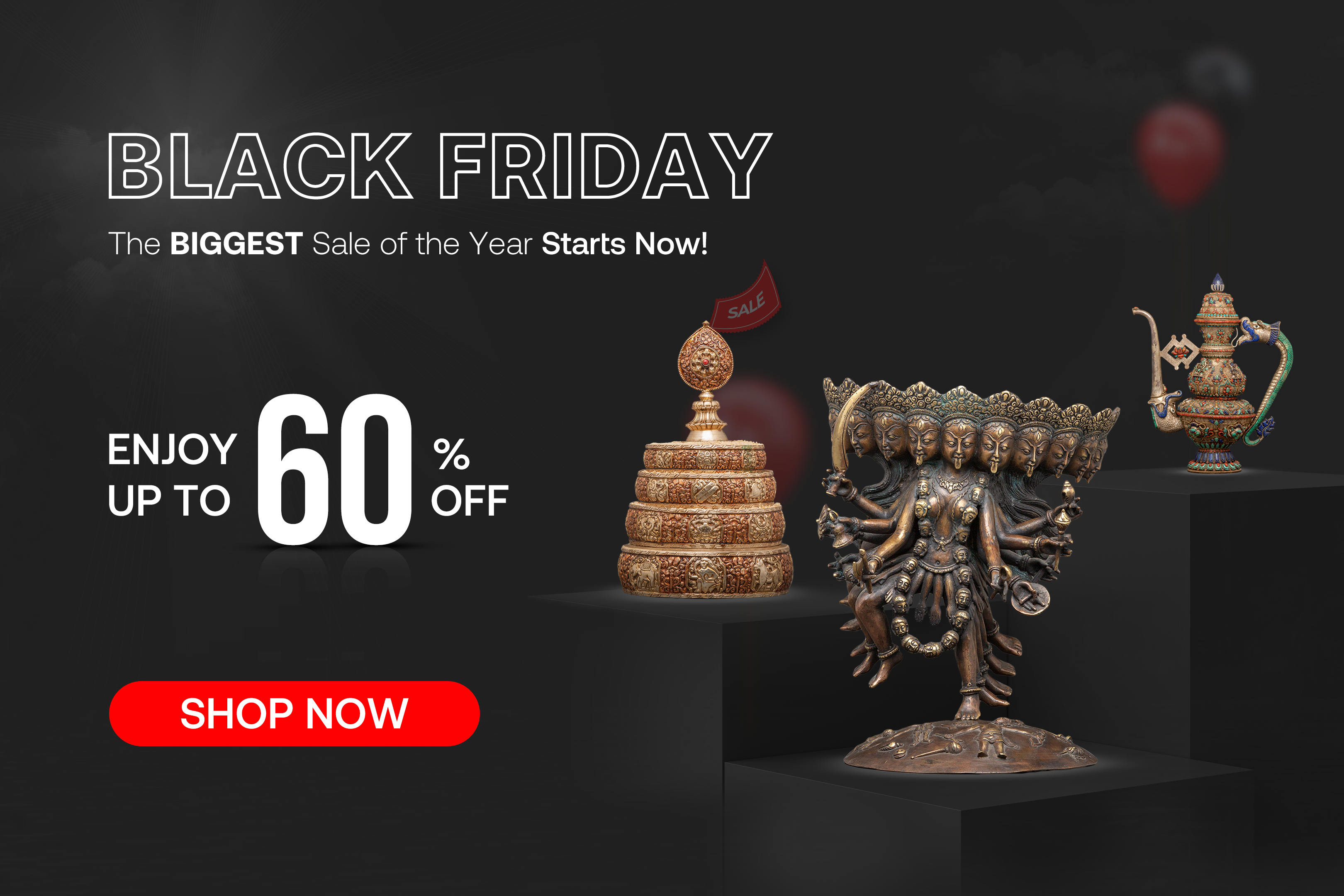The Tibetan Chöd Drum: A Spiritual Symphony of Liberation
The Tibetan Chöd Drum is a potent symbol in Tibetan Buddhism, encapsulating the core ideals of spiritual freedom and the transcendence of self. Beyond its musical function, this instrument serves as a conduit for profound meditation and ceremonial rites designed to sever the ties of attachment and ignorance.
In our in-depth analysis, we uncover the historical, symbolic, and practical dimensions of the Chöd Drum, illuminating its crucial role in guiding practitioners along their spiritual path.
Key Takeaways:
- The Tibetan Chöd Drum is a central instrument in Chöd practice, symbolizing the severance of ego and attachment.
- It is traditionally made from two human skull caps, representing the transformation of ignorance into wisdom.
- Chöd practice involves complex rituals combining chant, music, and meditation to confront and liberate from one's fears and attachments.
- The drum's sound is believed to summon spirits and deities, facilitating the practitioner's journey towards enlightenment.
Tibetan Chöd Drum: Awaken Your Inner Beat

Click here to view our Tibetan Chod Damaru
The Chöd Drum also referred to as the Chöd Damaru in Tibetan, holds significance beyond being a mere instrument. It is a vital spiritual implement utilized for centuries by Buddhists in the Himalayan regions, notably within tantric traditions.
Facilitating the Chöd practice, the drum aids in severing the ego and its attachments—a process represented by the term 'chöd,' meaning 'to cut.' This practice employs a blend of chanting, drumming, and visualization techniques to achieve its objectives.
Historical Background
The Origins of Chöd Practice
The roots of Chöd practice can be traced back to the 11th century, attributed to Machig Labdrön, a revered Tibetan mystic and yogini. This practice amalgamates elements from Tibetan Buddhism and the ancient Bon tradition, forging a distinctive path to enlightenment centered on overcoming fear and embracing selflessness for the greater good.
Evolution of the Chöd Drum
As Chöd practice evolved, so did the Chöd Drum itself. Initially, these drums were meticulously fashioned from natural materials sourced from the Himalayan terrain, each component carrying symbolic importance.
Across centuries, the craftsmanship and design of these drums have undergone refinement while retaining their profound spiritual significance.
Construction and Design of the Tibetan Chöd Drum
| Component | Material | Symbolic |
| Drumhead | Human skull caps | Impermanence and the transformation of ignorance |
| Handle | Wood or bone | The axis of the spiritual world |
| Strikers | Leather or human bone | The duality of existence |
The traditional Chöd Drum is a handheld percussion instrument featuring two sides. It is commonly crafted from a pair of human skull caps bound together with leather and embellished with intricate carvings of symbolic significance.
The utilization of human bones serves as a potent symbol, reminding practitioners of the transient nature of existence and the imperative of rising above worldly attachments.

The drum's surface and handle often boast intricate carvings or embellishments, each laden with extended depth. These may feature depictions of deities, mandalas, or mantras meticulously chosen to amplify the drum's spiritual potency.
Construction Process
Crafting a Chöd Drum is a profoundly spiritual endeavor, often accompanied by prayers and rituals to sanctify the instrument. Artisans specializing in these drums possess exceptional craftsmanship and a deep understanding of their sacred significance.
The process commences with selecting materials, each chosen for its symbolic importance and purity. The skull caps undergo purification rituals to ensure their suitability for spiritual use.
Assembling the drum involves securely binding the skull caps to the frame to produce the desired sound quality. The tension of the drumheads is adjustable by tightening or loosening the binding cords, allowing for tonal variations. The final stage entails meticulously decorating the drum, infusing it with layers of symbolic meaning, thus elevating its spiritual essence.
Physical Attributes Of The Drum
- Size and Shape
The Chöd Drum typically ranges from 20 to 25 centimeters in diameter, although sizes may vary depending on specific traditions and practitioner preferences. It is a handheld, double-sided drum with a slightly hourglass-like shape when viewed from the side, owing to the joining of two skull caps. This compact design enables practitioners to carry and play the drum during ceremonial dances and processions.
Materials
- Skull Caps (Kapālas): The defining feature of the Chöd Drum is its use of human skull caps for drumheads. These caps undergo meticulous selection and preparation to ensure cleanliness and the absence of residual matter. The employment of human skulls serves as a direct contemplation on the transient nature of life, inviting meditation on death and rebirth.
- Frame: The skull caps are affixed to a frame constructed from wood or metal, covered with leather or brocade. This frame secures the skull caps and enhances the drum's acoustics.
-
Handle: Equipped with a handle typically crafted from wood or bone, often adorned with intricate carvings or symbols, the drum allows practitioners to hold it during use comfortably.

Click here to view our Machig Labdron Chod Thangka
Symbolic Decorations
The Chöd Drum is adorned with symbolic motifs that amplify its spiritual significance, including:
- Mandalas: Symbolizing the cosmos and the practitioner's quest for enlightenment.
- Mantras: Sacred phrases like "Om Mani Padme Hum" invoke compassion and wisdom.
- Deity Images: Depictions of protective figures from Tibetan Buddhism, like Machig Labdrön and Padmasambhava.
- Vajra Symbols: Representing indestructibility and compassion potency, often found on the drum's handle or body.
Color Symbolism
The colors used in the drum's decoration carry symbolic meanings. For instance, red signifies life force and compassion's strength, while blue may represent the vast sky or emptiness, a fundamental Buddhist concept. Gold is often employed for its association with purity and enlightenment.
Symbolism and Significance
- The Drum as a Vessel of Liberation
The Chöd Drum transcends its role as a mere instrument, embodying the essence of Chöd practice. It symbolizes Buddhism's ultimate aim: liberation from the cycle of death and rebirth, known as samsara, and the attainment of enlightenment. Each drum beat serves as a clarion call to awaken, slicing through illusions and guiding practitioners toward spiritual liberation.
- Connection to Tantric Buddhism
In Tantric Buddhism, instruments like the Chöd Drum bridge the mundane and the spiritual realms, crafting a sonic landscape conducive to deep meditation and ceremonial rites. The drum's resonance is believed to summon protective deities and dispel negative energies, aiding practitioners in their spiritual odyssey.
The Practice of Chöd: Musical and Ritualistic Aspects
- Rituals and Ceremonies
Chöd practitioners perform elaborate rituals incorporating text recitation, drum usage, and intricate visualizations. These ceremonies often unfold in charnel grounds or other death-associated locales, underscoring the practice's focus on confronting and embracing impermanence.
- Psychological and Spiritual Dimensions
Chöd is a psychological and spiritual endeavor that challenges practitioners to confront their deepest fears and attachments. The drum's sound acts as a catalyst for inner metamorphosis, fostering personal liberation, compassion, and empathy for all sentient beings.
- The Drums of Liberation
Central to Chöd practice is the transformative sound of the drum, capable of slicing through ignorance and ego to foster a deeper connection with the divine. Its rhythm harmonizes with chants and visualizations, engendering a holistic spiritual experience.
- Integration with Other Instruments
In certain traditions, the Chöd Drum is complemented by bells and trumpets, each layering significance and aiding in deity invocation and obstacle removal on the path to enlightenment.
The Tibetan Chöd Drum is a profound testament to the spiritual journey of transcending ego and attachment toward enlightenment. Its symbolic construction, rich history, and integral role in Chöd practice underscore its significance as not merely a musical instrument but a sacred vehicle for liberation. Through its resounding beats, practitioners embark on a transformative odyssey, confronting fears and limitations to attain ultimate freedom and compassion for all sentient beings.















